Grow These 10 Uncommon Edibles
Gardening is a great hobby and stress reliever, especially for city dwellers, and many in Singapore have started growing edibles to enjoy the fruits of their labour. If you are looking for new ways to spruce up your garden, instead of growing commonly available edibles, why not try growing some unusual food plants you can proudly serve as a side dish at your next dinner gathering?
Read on for 10 uncommon edible plants, seldom seen in our local markets, and certain to surprise family and friends.
1. Red Velvet Okra
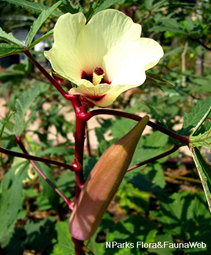
Red Velvet Okra. Photo credit: Vicky Lim Yen Ngoh
Name: Abelmoschus esculentus (Red Form)
Family: Malvaceae
Common Name: Red Velvet Okra
Many of us are familiar with the Okra, a common addition to many dishes here. But did you know that the shrubby plant, which is also known as the Lady’s Finger, can also produce red-coloured fruit? This variety, known as the Red Velvet Okra, can grow to about 1.5 m tall and is decorated with long finger-like crimson fruit. These fruits become woody as they mature, so remember to harvest them while they are still young for maximum flavour! Similar to regular Okra, the Red Velvet Okra tastes great boiled, steamed or stir-fried.
2. Elephant Foot Yam
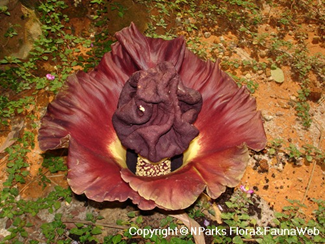
Elephant Foot Yam. Photo credit: Serena Lee Mei Lyn
Name: Amorphophallus paeoniifolius
Family: Araceae
Common Name: Elephant Foot Yam
You may find the Elephant Foot Yam a good substitute for potatoes. This plant, which can grow up to 2.5 m tall and occasionally produces an intriguing and showy inflorescence has truly tasty parts which lie underground. Its swollen roots have a starchy texture and can be harvested and cooked in curries and stews. Its leaves and leaf stalks are also edible. However, as the plant contains calcium oxalate crystals, which may cause irritation to skin, its tubers, leaves and stem must be thoroughly cooked before consumption.
3. Belimbing Hutan

Belimbing Hutan. Photo credit: Ang Wee Foong
Name: Baccaurea angulata
Family: Phyllanthaceae
Common Names: Belimbing Hutan, Red Angle Tampoi
The Belimbing Hutan bears interestingly shaped angular fruit with an intense ruby-red colour. Peeling these fruits reveals large seeds surrounded by a white juicy pulp, which has a sweet and sour taste, similar to its more common cousin, the Rambai (Baccaurea motleyana). As the Belimbing Hutan can grow to 21 m tall, it requires adequate space and may not be suitable for all gardens.
4. Kundangan
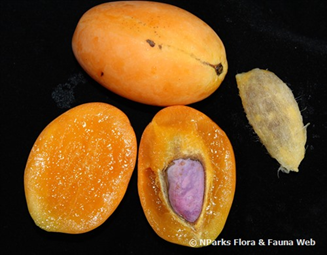
Photo credit: Shi Biying
Name: Bouea macrophylla
Family: Anacardiaceae
Common Names: Kundangan, Marian Plum
The Kundangan can grow up to 27 m tall and produces miniature mango-like fruit which is only 5 cm long. Despite their small size, these “mini-mangoes” are just as sweet as the regular mangoes (Mangifera indica). Occasionally, a few from your harvest may be sour to taste, but don’t discard them just yet! They can be used as a substitute for tamarind or lime in cooking. Also, its young leaves are violet coloured and may be steamed and eaten with rice.
5. Purple Bok Choy
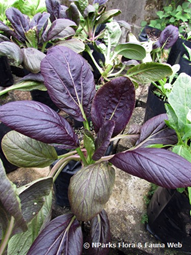
Photo credit: Vicky Lim Yen Ngoh
Name: Brassica rapa (Purple Bok Choy)
Family: Brassicaceae
Common Name: Purple Bok Choy
You have seen the Bok Choy, but did you know it also has a variety which has purple leaves? Prized for its rich colour, the Purple Bok Choy is a rare find in the market and on almost every gardener’s wishlist, as its leaves are both attractive and delicious. Avoid over-cooking this vegetable as they will lose their colour when heated over long periods of time.
6. Mangrove Apple
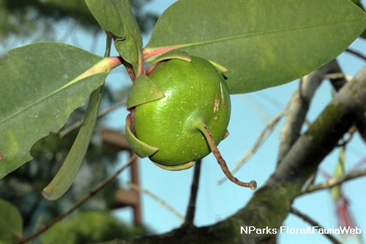
Photo credit: Arthur Ng
Name: Sonneratia caseolaris
Family: Lythraceae
Common Names: Mangrove Apple, Firefly Mangrove
The Mangrove Apple thrives in both mangrove and freshwater environments. Reaching up to 15 m tall, this tree is native to Singapore and produces pinkish night-blooming flowers that smell like sour milk. Its rounded fruit is unusual looking, having a star-shaped hat formed by persistent sepals. It is sour-tasting with a tinge of cheese flavour, and is commonly eaten cooked or raw in Indonesia and Borneo.
7. Engkala

Photo credit: Cerlin Ng
Name: Litsea garciae
Family: Lauraceae
Common Names: Engkala, Malai
Engkala is the perfect combination of beauty and taste. Its fruit is almost round, ripening from a bright green into an attractive pink and is often attached to a cup-shaped bract, resembling a small green hat! It can be eaten raw or steamed with rice, and tastes just like avocado. Engkala milkshake, anyone?
8. Mushroom Plant
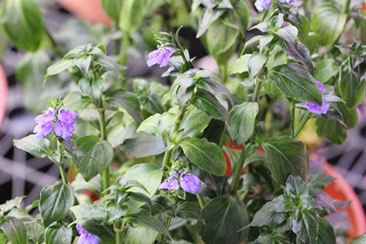
Photo credit: Jennie Tang Yurue
Name: Rungia klossii
Family: Acanthaceae
Common Name: Mushroom Plant
The Mushroom Plant tops the charts by having a strange combination of tastes. Although it has a strong resemblance to spinach, its leaves taste just like mushrooms! Its leaves and stems taste best when they are young and tender, and can be eaten raw in salads or cooked in soups, stews or stir-fried with garlic.
9. Coconilla
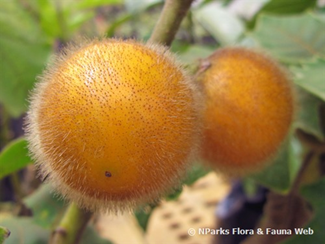
Photo credit: Vicky Lim Yen Ngoh
Name: Solanum stramoniifolium
Family: Solanaceae
Common Names: Coconilla, Hairy Eggplant
The Coconilla bears fruit that is densely covered with hairs and ripen from green to orange-red. Enjoy its taste by simply slicing it and then scooping its flesh out. It is sweet-sour tasting and can be cooked with sambal belacan or in a Thai curry style.
10. Akar Paku
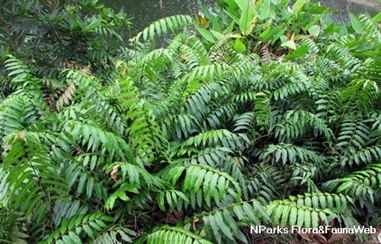
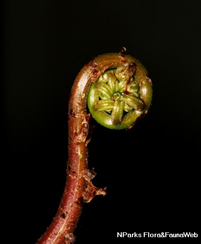
Photo credit: Vicky Lim Yen Ngoh (left); Arthur Ng (right)
Name: Stenochlaena palustris
Family: Blechnaceae
Common Name: Akar Paku
Most ferns are not edible, but there are always exceptions in nature. The young fronds of Akar Paku, a fern native to Singapore, are edible when thoroughly cooked. They taste similar to the Asparagus, and are delicious when cooked with sambal belacan. Yum!
Interested to grow these new and wonderful edibles at home? To get started, make a visit to any local nursery or garden centre to enquire about and purchase these species. You can also visit the Singapore Garden Festival from 21 July top 3 August, to pick up tips on growing edibles as well as attend informative workshops and exchange ideas with fellow community gardeners.
For more information on these and other plants which you can find in our gardens, parks and nature areas, check out NParks Flora & Fauna Web.
You may also be interested in learning more about community gardening by visiting CIB web page.
Happy gardening!
Text by Jessica Teo


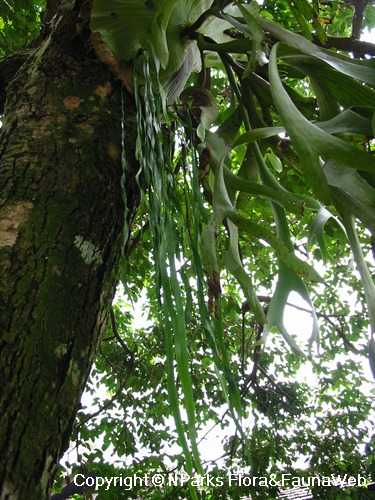


Have views or comments on this article? Let us know via this form. If you would like to give us feedback on any other areas relating to our parks and gardens, please submit via https://www.nparks.gov.sg/feedback